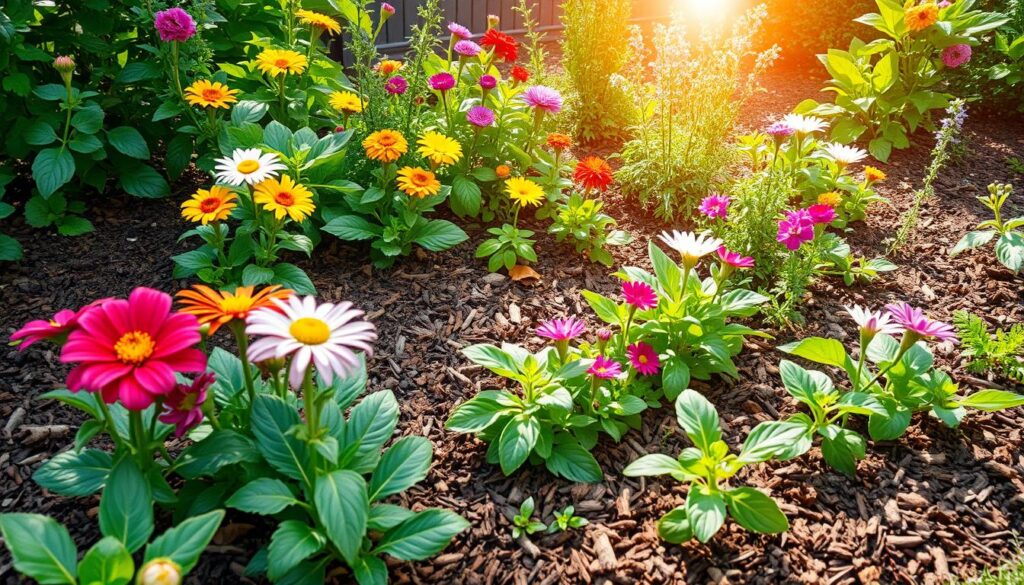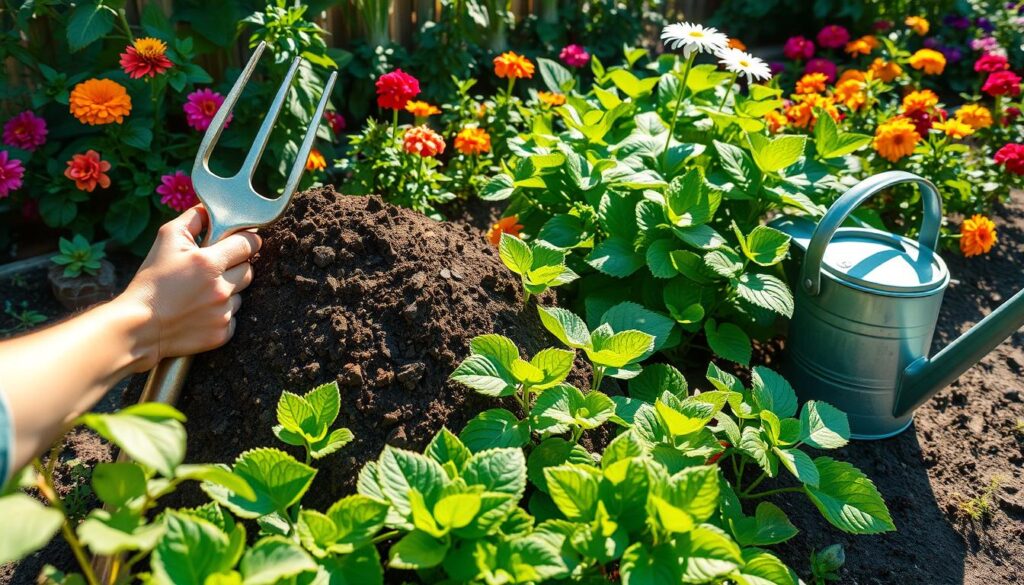Ever wondered why some gardens do well while others don’t, even with the same care? Knowing the basics of gardening, like soil, plants, and watering, can make your yard bloom. This article is full of tips for all gardeners, from beginners to experts. Learn how to make your garden a beautiful place!
Key Takeaways
- Understanding soil requirements is fundamental to successful gardening.
- Choosing the right plants can significantly impact your garden’s health.
- Implementing an efficient watering schedule is crucial for plant growth.
- Mulching plays a vital role in maintaining soil moisture and temperature.
- Regular pruning helps promote health and aesthetics in your plants.
- Companion planting can naturally enhance growth and deter pests.
- Seasonal maintenance is key to a thriving garden year-round.
Understanding Your Soil’s Needs
To grow a healthy garden, knowing about soil quality is key. Soil testing gives important insights for gardening. It helps you understand pH levels, which is crucial for plant health.
Test Your Soil pH
Soil pH testing is the first step in gardening. A good pH level means plants get the nutrients they need. There are different ways to test your soil:
- DIY kits: Easy to find and use, giving quick results.
- Professional soil testing services: Offer detailed analysis and advice for your garden.
Testing your soil regularly keeps it in the best condition. This improves soil quality and supports eco-friendly gardening.
Improve Soil Quality
Boosting soil quality can greatly help your plants. Adding organic materials like compost and mulch makes a big difference:
- Compost: Makes soil better for plants by adding nutrients and improving structure.
- Mulch: Keeps soil moist, stops weeds, and warms it up.
These actions not only make your soil better but also help the environment. They support a sustainable gardening approach.
Topsoil vs. Subsoil
Knowing the difference between topsoil and subsoil is crucial. Topsoil is at the top and is full of nutrients and organic matter. Subsoil is below and has minerals but less organic matter.
| Feature | Topsoil | Subsoil |
|---|---|---|
| Location | Top layer | Below topsoil |
| Composition | Organic material, nutrients | Minerals, lower nutrient content |
| Role in Plant Health | Supports growth | Aids root stability |
Knowing about topsoil and subsoil helps gardeners manage their soil better. This leads to a successful gardening experience.
Choosing the Right Plants for Your Climate
Starting a garden means picking the right plants for your climate. Using native plants makes your garden more sustainable and supports a healthy ecosystem. Knowing when to plant is key to a successful garden all year round.
Native Plants for Sustainable Gardening
Native plants love their local home and need less water and care. They fit right into your soil, climate, and pests. This makes them great for those who care about the environment.
By choosing native plants, you help local wildlife like bees and butterflies. They need these plants to survive.
Seasonal Plant Selections
Plan your garden by season for a constant flow of blooms. Here are some top picks for each season:
| Season | Recommended Plants |
|---|---|
| Spring | Daffodils, Tulips, Primroses |
| Summer | Sunflowers, Echinacea, Zinnias |
| Fall | Asters, Sedum, Mums |
| Winter | Holly, Pansies, Evergreens |
Hardy vs. Tender Varieties
Knowing the difference between hardy and tender plants is key. Hardy plants can handle cold, while tender ones need protection. This knowledge helps your garden thrive.
Hardy plants are good for cold areas. Tender plants need a safe spot to grow well. Use this info to make your garden strong and colorful.
Creating an Effective Watering Schedule
Creating a good watering schedule is key to a healthy garden. Knowing when to water, using the right methods, and knowing when plants need water helps plants grow strong and healthy.
Best Times to Water
Watering in the early morning or late afternoon is best. It reduces evaporation and helps plants soak up water better. Morning watering gives plants water before it gets hot. Evening watering gives them water before night.
Methods for Efficient Watering
Using smart watering methods can make your indoor garden better. Here are some good options:
- Drip irrigation: Water goes straight to the roots.
- Soaker hoses: Water seeps into the soil through the hose.
- Watering cans: Perfect for pots, letting you control how much water you use.
Signs Your Plants Need Water
Knowing when plants need water is important for a healthy garden. Look for these signs:
- Wilting leaves
- Dry, cracked soil
- Color change in foliage
By using these smart strategies, you can create a watering schedule that helps your plants thrive.
| Watering Method | Benefits | Best Use Case |
|---|---|---|
| Drip Irrigation | Minimizes evaporation; saves water | Large gardens; raised beds |
| Soaker Hoses | Easy to install; provides consistent moisture | Row planting; mulched areas |
| Watering Cans | Precise watering; no tech needed | Container plants; small gardens |
The Importance of Mulching
Mulching is key to a healthy garden. It boosts plant growth and makes garden care easier. Knowing the right mulch and how to use it can improve your vegetable garden.
Benefits of Mulch
Mulch offers many benefits for your garden:
- Moisture retention: Mulch keeps soil moist, cutting down on watering.
- Weed suppression: Mulch stops weeds from growing, giving plants more room to thrive.
- Soil temperature regulation: Mulch keeps soil temperature stable, which is good for plants.
Types of Mulch
Choosing the right mulch is crucial. Here are the most common types:
- Organic mulches: These include wood chips, straw, and grass clippings that break down and improve soil.
- Inorganic mulches: Gravel, stones, and synthetic fibers provide long-lasting coverage without adding nutrients.
How to Properly Apply Mulch
Applying mulch is simple but needs careful attention. Follow these tips for a great garden:
- Start with a clean garden bed by removing weeds and debris.
- Spread 2-4 inches of mulch, making sure it doesn’t touch plant stems.
- Keep the mulch layer up, adding more as needed to keep its benefits.

Using mulch well, choosing the right type, and applying it correctly can make your garden flourish.
Pruning: Timing and Techniques
Pruning is key to a healthy garden. It boosts plant health, growth, and flower blooms. Knowing the right gardening tools and methods is crucial. Here are the essential tools, when to prune, and common mistakes to steer clear of.
Tools You’ll Need
For the best pruning results, the right tools are vital. Here are some must-haves:
- Pruners: Perfect for small branches and live stems.
- Loppers: Great for thicker branches, offering longer reach.
- Saws: Needed for larger limbs and older wood.
- Gloves: Keep hands safe from thorns and debris.
- Drop cloth: Makes cleanup easier by catching clippings.
When to Prune
Pruning timing is crucial. The best time to prune depends on the plant type:
- Trees: Prune in late winter or early spring before new growth starts.
- Shrubs: Prune early spring for flowering shrubs; after blooming for others like hydrangeas.
- Perennials: Prune in late fall or early spring before new growth begins.
Common Pruning Mistakes
Even experienced gardeners can make pruning mistakes. Knowing these common errors can help improve your technique:
- Excessive cutting: Cutting too much foliage can stress plants and slow growth.
- Poor timing: Pruning at the wrong time can cause loss of flowers or fruit.
- Neglecting cleanup: Leaving cuttings on the ground can spread disease.
- Using dull tools: Dull blades can cause jagged cuts, making plants vulnerable.
Utilizing Companion Planting
Companion planting is a way to grow different plants together. It helps them grow better and keeps pests away. This method uses plants that help each other, making the garden healthier. It also means you might not need to use as many chemicals.
Benefits of Plant Companions
When plants are grown together, they can offer many benefits. Some key advantages include:
- Pest Deterrence: Some plants keep pests away from their neighbors.
- Mutual Growth Support: Plants can help each other grow by sharing nutrients or blooming together.
- Microclimate Creation: Taller plants can shade smaller ones, helping them grow better.
Top Plant Pairs for Your Garden
Choosing the right plant pairs can make gardening better. Here are some classic combinations:
| Plant Pair | Benefits |
|---|---|
| Tomatoes & Basil | Basil keeps pests away and helps tomatoes grow. |
| Carrots & Onions | Onions keep pests away from carrots. |
| Cucumbers & Nasturtiums | Nasturtiums draw aphids away from cucumbers. |
Avoiding Plant Enemies
Some plants don’t get along and can harm each other. Watch out for these common problems:
- Beans and Onions: Onions can slow down bean growth.
- Potatoes and Tomatoes: Both get sick from the same diseases, so they’re not good together.
- Carrots and Dill: Dill can hurt carrot growth if planted close.
Pest Management Strategies
Keeping your garden healthy means managing pests well. You can protect your plants and keep the good bugs around. Start with natural ways to keep pests away. This is better for your garden and the environment.
Natural Pest Deterrents
Using natural pest control is a smart choice. It’s safer than chemicals. Here are some good options:
- Neem Oil: Made from neem seeds, it stops pests from reproducing.
- Garlic Spray: Mix garlic with water to keep insects away.
- Diatomaceous Earth: A powder that kills soft pests but not good bugs.
When to Use Pesticides
At times, you might need pesticides. But choose them wisely. Think about the impact on your garden. Here are some tips:
- Use pesticides when it’s calm outside to avoid spreading.
- Hit pests early when they’re young and easier to control.
- Go for pesticides that work for a long time.
Beneficial Insects to Attract
Attracting good bugs helps control pests naturally. These bugs eat the bad ones. Try to get:
- Ladybugs: They eat aphids and other small pests.
- Lacewings: Their young eat many garden pests.
- Parasitic Wasps: They keep caterpillars from eating your plants.
By using natural methods, pesticides wisely, and attracting good bugs, you’ll have a healthy garden. It will be full of life and growth.
Fertilizing for Optimal Growth
Proper fertilizing is key for your garden’s growth. Knowing the difference between organic and synthetic fertilizers is important. The right choice can boost plant health and protect the environment.
Organic vs. Synthetic Fertilizers
Organic fertilizers come from nature and improve soil health. They release nutrients slowly, helping soil structure and microbes. Examples include compost, manure, and bone meal.
Synthetic fertilizers give quick nutrients but can harm soil and cause runoff. Knowing the difference helps gardeners choose wisely.
How to Read Fertilizer Labels
Reading fertilizer labels is essential. The N-P-K ratio shows nitrogen, phosphorus, and potassium levels. For example, 10-10-10 means equal amounts of each.
Knowing these numbers helps pick the right fertilizer for your garden. Different plants need different nutrients.
Signs of Nutrient Deficiency
Pay attention to your plants to spot nutrient issues. Common signs include:
- Yellowing leaves: Often indicates a nitrogen deficiency.
- Purple leaves: May suggest a phosphorus deficiency.
- Stunted growth: Can be a sign of insufficient potassium.
Spotting these signs helps gardeners adjust fertilizers. This ensures plants grow well and yield plenty.

Seasonal Gardening Tips
Changing your gardening ways with the seasons keeps your plants healthy and your garden lively. Knowing what each season needs is key to a successful garden. Here are tips for spring, summer, and autumn gardening.
Preparing for Spring Planting
When it gets warmer, it’s time to get ready for spring. First, check and improve your soil for strong roots. Add compost or fertilizer to make the soil better.
Pick plants that bloom early, like pansies or daffodils. They add color and interest before it gets too hot. These steps make your garden beautiful and productive.
Summer Maintenance Techniques
Summer is when you need to keep your garden in top shape. Make sure to water plants deeply and often when it’s hot. Use mulch to keep the soil moist and stop weeds.
Keep an eye out for pests and diseases. Catching them early stops them from causing big problems. These steps help your garden stay green and healthy all summer.
Autumn Cleanup and Winter Prep
When summer ends, it’s time for autumn cleanup. Get rid of dead plants and debris to prevent diseases. Plant bulbs for flowers next spring.
Get your garden ready for winter by mulching perennials. This protects them from cold weather. Good preparation helps your garden grow well next year.
| Season | Tasks | Benefits |
|---|---|---|
| Spring | Soil amendment, early bloom selection | Healthy roots, vibrant colors |
| Summer | Watering, mulch application, pest management | Moisture retention, disease prevention |
| Autumn | Debris removal, bulb planting, mulching | Reduced diseases, winter insulation |
Designing a Beautiful Landscape
Creating a stunning landscape design needs careful thought. It’s important to consider elements that work well together. Focal points, like a beautiful sculpture or a colorful flower patch, are key. They draw the eye and make your garden the main attraction.
Creating Focal Points
Focal points are vital for adding beauty and interest to your garden. They help organize the space and guide visitors. Use dramatic plants or interesting structures to grab attention and tell a story in your landscape.
The Role of Color in Gardening
Color is crucial in making your garden look good. The right mix of colors can create a certain mood. When designing your landscape, think about colors that go well together. This will make your garden beautiful and full of character.
Incorporating Hardscapes and Paths
Adding hardscapes like patios, walls, and paths is important for both looks and function. They define areas and make moving around your garden easy. Choose materials that match your plants and colors to enhance your design and make it last.
FAQ
What are some essential gardening tips for beginners?
First, learn about your soil and what it needs. This is key for plants to grow well. Pick easy plants like herbs or veggies for your first garden. Make sure to water them regularly.
Don’t be afraid to ask for help. Local gardening centers and websites have lots of tips for beginners.
What are organic gardening tips I should follow?
Use organic fertilizers and natural ways to fight pests. Companion planting and natural repellents are good options. Add compost to improve your soil.
Plant native species. They need less care and fit your local climate better.
How can I improve my container gardening?
Use a good potting mix that holds moisture but drains well. Pick plants that fit your containers. Water often, especially when it’s hot.
Adding mulch helps keep the soil moist.
What are some vegetable gardening tips for a successful harvest?
Use raised beds for better drainage. Fight pests with organic methods. Make sure plants have enough space for air.
Rotate your crops to keep the soil healthy and prevent diseases.
How do seasonal gardening tips differ by climate?
Seasonal tips change a lot based on your climate. In warm areas, you can start planting sooner. In cooler places, watch out for frost.
Learn about your local climate to pick the right plants and care for them.
What are some indoor gardening tips for growing houseplants?
Choose plants that do well in your home’s light and humidity. Check for pests often. Make sure plants drain well and don’t overwater.
Use organic soil for the best results.
How can I practice sustainable gardening?
Compost kitchen scraps and use organic fertilizers. Save water with smart watering methods. Plant native species and attract beneficial insects.
What is the best mulch for my garden?
Organic mulches like wood chips, straw, and grass clippings are great. They keep moisture in, stop weeds, and improve soil. Pick one that fits your plants and what’s available locally.
When is the best time to prune my plants?
The best time to prune depends on the plant. For many trees and shrubs, late winter or early spring is best. Some plants need pruning after they bloom. Always check what’s best for your plants.
How can I attract beneficial insects to my garden?
Plant a mix of flowers that bloom at different times. This attracts helpful insects. Choose plants like marigolds and yarrow. Avoid broad-spectrum pesticides that harm these insects.


